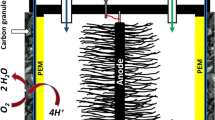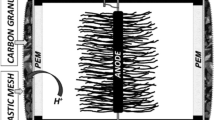Abstract
Microbial fuel cell (MFC) based sensing was explored to provide for the development of an in situ bioremediation monitoring approach for substrate concentrations and microbial respiration rates. MFC systems were examined in column systems where Shewanella oneidensis MR1 used an external electron acceptor (an electrode) to metabolize lactate (a bioremediation additive) to acetate. Column systems were operated with varying influent lactate concentrations (0–41 mM) and monitored for current generation (0.01–0.39 mA). Biological current generation paralleled bulk phase lactate concentration both in the influent and in the bulk phase at the anode; current values were correlated to lactate concentration at the anode (R 2 = 0.9), The electrical signal provided real-time information for electron donor availability and biological activity. These results have practical implications for efficient and inexpensive real-time monitoring of in situ bioremediation processes where information on substrate concentrations is often difficult to obtain and where information on the rate and nature of metabolic processes is needed.



Similar content being viewed by others
References
Anderson RT, Vrionis HA, Ortiz-Bernad I et al (2003) Stimulating the in situ activity of Geobacter species to remove uranium from the groundwater of a uranium-contaminated aquifer. Appl Environ Microb 69:5884–5891
Bencheikh-Latmani R, Williams SM, Haucke L et al (2005) Global transcriptional profiling of Shewanella oneidensis MR-1 during Cr(VI) and U(VI) reduction. Appl Environ Microb 71:7453–7460
Chu M, Kitaradis PK, McCarty PL (2003) Effects of biomass accumulation on microbially enhanced dissolution of a PCE pool: a numerical simulation. J Contam Hydrol 65:79–100
Dybas MJ, Barcelona M, Bezborodnikov S et al (1998) Pilot-scale evaluation of bioaugmentation for in-situ remediation of a carbon tetrachloride contaminated aquifer. Environ Sci Technol 32:3598–3611
Freguia S, Rabaey K, Yuan ZG et al (2007) Electron and carbon balances in microbial fuel cells reveal temporary bacterial storage behavior during electricity generation. Environ Sci Technol 41:2915–2921
Guerin TF, Mondido M, McClenn B et al (2001) Application of resazurin for estimating abundance of contaminant-degrading micro-organisms. Lett Appl Microbiol 32:340–345
Kim HJ, Hyun MS, Chang IS et al (1999) A microbial fuel cell type lactate biosensor using a metal-reducing bacterium, Shewanella putrefaciens. J Microbol Biotech 9:365–367
Liu H, Cheng SA, Logan BE (2005) Production of electricity from acetate or butyrate using a single-chamber microbial fuel cell. Environ Sci Technol 39:658–662
Logan BE, Hamelers B, Rozendal R et al (2006) Microbial fuel cells: Methodology and technology. Environ Sci Technol 40:5181–5192
Lovley DR (2006) Microbial fuel cells: novel microbial physiologies and engineering approaches. Curr Opin Biotech 17:327–332
Picardal F, Arnold RG, Huey BB (1995) Effects of electron-donor and acceptor conditions on reductive dehalogenation of tetrachloromethane by Shewanella-putrefaciens-200. Appl Environ Microb 61:8–12
Rabaey K, Lissens G, Siciliano SD et al (2003) A microbial fuel cell capable of converting glucose to electricity at high rate and efficiency. Biotechnol Lett 25:1531–1535
Ringeisen BR, Henderson E, Wu PK et al (2006) High power density from a miniature microbial fuel cell using Shewanella oneidensis DSP10. Environ Sci Technol 40:2629–2634
Salanitro JP, Johnson PC, Spinnler GE et al (2000) Field scale demonstration of enhanced MTBE bioremediation through aquifer bioaugmentation and oxygenation. Environ Sci Technol 34:4152–4162
Semprini L, McCarty PL (1991) Comparison between model simulations and field results for in situ biorestoration of chlorinated aliphatics. 1. Biostimulation of methanotrophic bacteria. Ground Water 29:365–374
Sung Y, Fletcher KF, Ritalaliti KM et al (2006) Geobacter lovleyi sp nov strain SZ, a novel metal-reducing and tetrachloroethene-dechlorinating bacterium. Appl Environ Microb 72:2775–2782
Thullner M, Schroth MH, Zeyer J et al (2004) Modeling of a microbial growth experiment with bioclogging in a two-dimensional saturated porous media flow field. J Contam Hydrol 70:37–62
Turner APF (2000) Biochemistry–Biosensors sense and sensitivity. Science 290:1315–1317
U.S. Census Bureau (2002) Pollution abatement costs and expenditures: 1999. U.S. Government Printing Office, Washington DC
Wu WM, Carley J, Gentry Tf et al (2006) Pilot-scale in situ bioremedation of uranium in a highly contaminated aquifer. 2. Reduction of U(VI) and geochemical control of U(VI) bioavailability. Environ Sci Technol 40:3986–3995
Acknowledgments
Dr. Rizlan Bernier-Latmani, of EPFL in Lausanne, Switzerland donated the S. oneidensis MR1 culture and provided advice on handling and usage. Mr. Ernst Bleiker of ETH Zurich provided the LabView program and insight into the electrical system. Prof. Dr. J. Zeyer and Dr. Martin Schroth of ETH Zurich provided access to their Ion Chromatography System.
Author information
Authors and Affiliations
Corresponding author
Electronic supplementary material
Below is the link to the electronic supplementary material.
Rights and permissions
About this article
Cite this article
Tront, J.M., Fortner, J.D., Plötze, M. et al. Microbial fuel cell technology for measurement of microbial respiration of lactate as an example of bioremediation amendment. Biotechnol Lett 30, 1385–1390 (2008). https://doi.org/10.1007/s10529-008-9707-4
Received:
Revised:
Accepted:
Published:
Issue Date:
DOI: https://doi.org/10.1007/s10529-008-9707-4




